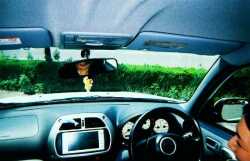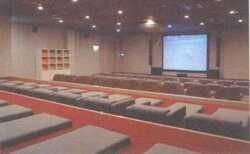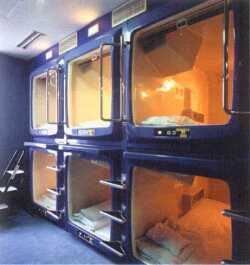|
My visit to Kagawa was special because I got to see my good friend Chika. Chika was
my conversation partner for about a year and a half, back around 2000. (Chika, please
tell me if this is incorrect.) We met once a week and helped each other with language.
She helped me with Japanese and I helped her with English. In the process, we became
good friends.
Our first stop was Marugame-jo (castle). Marugame-jo dates back to 1597. It has
stepped stone walls over 50 meters (164 feet) high. You can't really see from the
photograph, but the area around it is truly beautiful. When we got there, I had this
moment where I had to stop talking suddenly and admire the surroundings.
Here is a most unworthy photograph of this beautiful part of earth. That is, of course,
Chika.
|

|
|
After Marugame-jo, Chika asked me where I'd like to go. To her surprise, I asked to see a Japanese
library. We went looking for Marugame library, but it was closed. We ended up at the
Marugame Genichiro-Inokuma Museum of Contemporary Art (MIMOCA). See the link below. We saw an exhibit
of work by Wolfgang Laib and some other very "modern" art work.
From there, we went to the Sakaide Donut Shop and got donuts.
Here is a picture of Chika.
|

|
|
One thing that I enjoyed very much was Chika's car. Well, the car was very comfortable, but it had
a really neat computer in it. When she wanted to go somewhere, say Zentsuji Temple, she would type in
the name into the computer (in Japanese). It would make a map of how to get there. As she drove, it would
give her verbal instructions. That was neat, in itself. It could also play DVDs. When she backed up,
it would switch to a very useful video camera view of whatever was behind her. It was stable enough to
drive by. Here's a picture of the computer in her car.
|

|
|
As evening approached, we went to a travel agency to get advice on a place to stay. For cheap accomodation,
they recommended the Shikoku Kenko-mura. Man, this place was weird!
When you arrive, you lock up your shoes in a shoe locker. When you check in, you give them the key
in exchange for a locker key, a towel, and a uniform. You can't
have the key back until you check out. In other words, you can't leave the building until you're ready to check out
completely. Most people wear the strange blue uniform. It's like a hospital smock. Blue shorts and a blue shirt.
In general, people sleep in a big room full of easy chairs. There are maybe 200 easy chairs in a huge room. If you don't
like that, there is another huge room with tatami mats where you can sleep. You just get a sheet and blanket off of a shelf.
Really, they'll let you sleep anywhere. The lights are on 24 hours a day. In these sleeping rooms, there is a TV on most of
the time. One of the rooms turns off the TV at midnight. Oh yeah, people smoke everywhere. About 25 feet from the sleeping
room, there is a room with pachinko machines, slot machines, and video games. The chair room was too weird for me. I paid extra
to sleep in a capsule.
At right, you see two of the chair rooms and the capsule room. This is not a capsule hotel, per se. They just have capsules
as an added feature for people who want privacy when they sleep. These photos were taken from the pamphlet I got at this place.
My capsule was certainly big enough to be comfortable, even with my huge backpack inside with me.
There was a TV inside. There was a very weak fan but no air conditioning. Therefore, it got really hot at night. I was glad
to leave the next morning. It was pretty cheap. Normally, it is around ¥1500 (about US $13) per night. I paid extra for
the capsule. There was also a surcharge of around ¥300 (about US $2.60) for being tall.
Weird, weird, weird! One night was definitely enough! However, it was a fascinating experience.
|



|
 Kagawa prefecture
Kagawa prefecture





